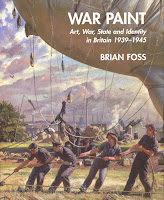 Brian Foss is Professor, Art History Department, Concordia University.
Brian Foss is Professor, Art History Department, Concordia University.He applied the "Page 99 Test" to his new book, War Paint: Art, War, State and Identity in Britain, 1939-1945, and reported the following:
Page 99 of War Paint is from the chapter “‘These Most Exacting Jobs’: Women’s Work in Art and War.” Like the rest of the chapter, it examines the often contradictory process by which Britain defined itself, and ultimately justified its very existence, at a time of massive upheaval and threat of invasion. On the one hand the art – like the society of which it was a part – recognised and celebrated women’s supposedly “unfeminine” contributions to war work. At the same time, though, both art and society often soft-peddled those contributions by characterising them as variations on pre-war gender traditions and stability. To what degree did the drastic recasting of gender roles during the war threaten the conservative pre-war definitions, and how did war art contribute to that discussion? Page 99 is thus a part of the examination – present throughout the book (and not limited to consideration of gender) – of how war art helped articulate a British identity that responded to the chaotic present. Related but briefer discussions of the correlation between wartime national identity and gender are also present in chapters on images of air raid damage and of military combat.Read more about War Paint at the Yale University Press website.
But page 99 does not touch upon other major themes of the book. The most important of these is War Paint’s analysis of how war art revitalised and restructured the relationship between British art, state patronage (which before the war had been extremely weak), and public interest (which before 1939 had widely seen art – when the subject came up at all – as being largely irrelevant to daily life). While these ideas are minor themes in the chapters dealing with images of air raids, military actions and “women’s work” (including page 99), they are more highly present in the chapters on artists’ finances, on war art as cultural propaganda, and on debates about the advantages and dangers of state involvement in the arts.
--Marshal Zeringue



